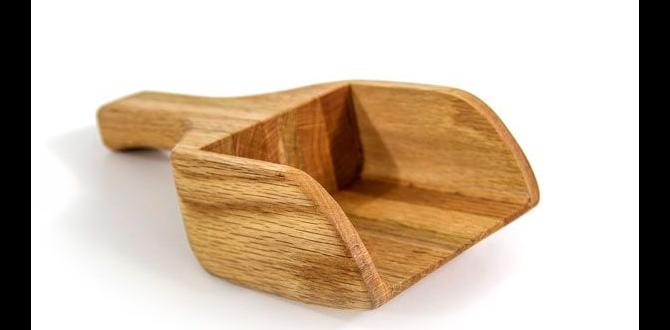Quick Summary:
Checking nail depth ensures your nails are driven correctly—not too deep (damaging wood) or too shallow (weak hold). With the right tools and a few simple steps, you can easily verify nail seating for professional-looking results on any DIY project.
Hey there, DIY enthusiasts! Jack Shaffer here from Nailerguy. Ever finish a project only to notice some nails are sticking out a bit, or worse, have punched clean through the wood surface? It’s a common hiccup that can really mar the look of your hard work. Getting the nail depth just right is key to a strong, clean finish. Don’t let a stray nail head or an overly proud fastener leave you frustrated. This guide is here to walk you through exactly how to check nail depth, making sure your projects turn out beautifully, every single time.
In this guide, we’ll cover what the ideal nail depth looks like, the simple tools you can use to check it, and a step-by-step process to ensure perfection. You’ll be admiring your flush, securely fastened projects in no time!
Table of Contents
Why Nail Depth Matters: More Than Just Looks
You might think, “It’s just a nail, how important can the depth really be?” Well, it’s more important than you might first imagine! Proper nail depth is crucial for both the aesthetic appeal and the structural integrity of your woodworking projects. When nails are driven correctly, they sit flush with or slightly below the surface, providing a clean look and a secure hold.
Driving a nail too deep can be just as problematic as leaving it too shallow. Too deep, and you risk damaging the wood fibers around the nail head, weakening the joint and creating an unsightly dimple or blowout. This is especially concerning with softer woods or when working near the edges of your material. Imagine building a beautiful bookshelf only to have the particleboard crumble around the nail heads!
On the other hand, nails driven too shallow create an obvious structural weakness. The fastener won’t be anchored properly, meaning the pieces you’re joining might shift or pull apart over time. This not only looks bad, with nail heads protruding awkwardly, but it can compromise the entire project’s durability. Think about a deck railing that feels wobbly because the nails are barely holding on – not a safe situation!
Achieving the right nail depth is a sign of craftsmanship. It shows attention to detail and ensures your project will stand the test of time. Luckily, it’s a skill that’s easy to learn and master with a little practice and the right approach. We’ll get into the nitty-gritty of how to achieve this perfect balance.
Understanding the “Ideal” Nail Depth
So, what exactly is the “ideal” nail depth? In most woodworking applications, the goal is to have the nail head sitting slightly below the surface of the wood. This is often referred to as being “countersunk” or “seated flush.”
For general construction and framing, a nail might be driven so the head is flush with the wood surface. This still provides a good grip. However, for fine woodworking, furniture making, or projects where you plan to finish the wood (like painting or staining), you’ll want the nail head to be slightly embedded. This allows you to easily fill the small indentation with wood filler or putty, creating a seamless finish that hides the fasteners completely.
The exact depth can vary slightly depending on the type of wood you’re using and the specific application. For instance, harder woods can sometimes tolerate a slightly deeper drive without significant damage, while softer woods need a more delicate touch. The thickness of the material also plays a role; you don’t want nails poking through the other side!
A good rule of thumb for many projects is to aim for the nail head to be about 1/16 to 1/8 of an inch below the surface. This depth is enough to be easily filled and covered but not so deep that it causes excessive damage to the wood. It’s about finding that sweet spot that provides security and a clean finish.
Tools for Checking Nail Depth
You don’t need super high-tech equipment to check your nail depth accurately. In fact, some of the best tools are the ones you likely already have around your workshop or home. Here are a few reliable options:
- Your Fingertip: Believe it or not, your fingertip is often the most sensitive and readily available tool. Gently slide your fingertip across the nail head and the surrounding wood surface. You can easily feel if the nail is proud (sticking up), flush, or slightly below the surface. This is your first line of defense and great for quick checks after each nail is driven.
- A Ruler or Measuring Tape: For a more precise measurement, a standard ruler or measuring tape can be used. You’ll want to place the edge of the ruler directly alongside the nail and note the measurement to the wood surface, then compare it to the measurement at the very top of the nail head. This is a bit more hands-on but provides quantifiable data.
- A Small Block of Wood (as a reference): Sometimes, even a small, flat piece of scrap wood can help. Place the scrap wood next to the nail. If you can easily see a gap between the top of the nail and the scrap wood when it’s resting on the surface, the nail is too shallow. If the scrap wood rocks unevenly, the nail might be too deep or at an angle.
- Calipers (Digital or Vernier): For the ultimate precision, especially in fine woodworking or cabinetry, calipers are your best friend. Digital calipers or Vernier calipers allow you to measure the exact distance between the nail head and the wood surface with incredible accuracy. Many digital calipers have a “zero” function that can make taking precise measurements easier. For example, you can zero the tool with the jaws resting on the wood surface and then open them until they just touch the nail head to get a direct reading of the depth.
- A Pencil or Marking Tool: Sometimes, you just need to “feel” the difference. Gently rub a pencil or a dull scriber across the surface. If it catches on the nail head, it’s too high. If it glides smoothly over the surface except for a tiny indentation, it’s likely just right.
The best tool for you will depend on the type of project, the materials you’re working with, and your personal preference. For most DIYers, a combination of fingertip checks and the occasional ruler measurement will suffice.
Step-by-Step: How to Check Nail Depth
Checking nail depth is straightforward once you know what to look for and how to do it. Here’s a simple, step-by-step process you can follow:
Step 1: Prepare Your Work Area and Tools
Before you even pick up your nailer, make sure you have your chosen measuring tool (fingertip, ruler, or calipers) readily accessible. Clear any sawdust or debris from the surface around where you’ve driven a nail. A clean surface makes it easier to feel or see any discrepancies in depth.
Step 2: Drive the Nail
Using your nail gun or hammer, drive the fastener into the wood. For pneumatic nailers, ensure your air pressure is set correctly. If using a hammer, aim for a firm, controlled strike. It’s often a good idea to test your nailer on a scrap piece of the same material first to get a feel for the depth control settings.
Step 3: The Initial Fingertip Check
Immediately after driving the nail, gently run your fingertip over the nail head and the surrounding wood. Try to feel for anything sticking up or any significant sinking.
- If you feel the nail head clearly protruding: It’s too shallow. You’ll likely need to drive it a bit deeper.
- If your fingertip sinks into the wood around the nail: It might be too deep, or there might be some wood fiber damage.
- If you feel a slight depression or no protrusion at all, with a smooth transition from wood to nail: This is usually the sweet spot!
Step 4: Refined Measurement (If Needed)
If your fingertip check is ambiguous, or if you need more precision:
Using a Ruler:
- Place the edge of your ruler directly against the surface of the wood, parallel to the nail.
- Carefully read the measurement where the ruler meets the wood surface.
- Now, move the ruler so its edge is touching the very top of the nail head.
- Read this new measurement.
- The difference between these two readings tells you how deep the nail is. Aim for that 1/16″ to 1/8″ below the surface.
Using Calipers:
- If using digital calipers, place the jaws on the wood surface and press the “zero” button. This sets the surface as your reference point.
- Carefully open the jaws until they just touch the top of the nail head.
- Read the measurement displayed on the calipers. A reading between 0.0625 inches (1/16″) and 0.125 inches (1/8″) is usually ideal.
- For Vernier calipers, you’ll take two measurements: one to the wood surface and one to the nail head, then subtract the former from the latter.
Step 5: Adjust if Necessary
Based on your checks:
- If a nail is slightly too high: You can often fix this by carefully driving it in a little further. Be cautious not to overdo it. A quick, controlled tap with a hammer or a very short burst from your nailer (if adjustable) might do the trick.
- If a nail is too deep and has caused damage: It’s usually best to remove it and drive a new one. Use a nail puller or claw hammer to carefully extract the damaged nail, fill the old hole with wood filler, and then drive a new nail nearby, ensuring correct depth this time.
- If a nail is perfectly seated: Great job! Move on to the next one.
Step 6: Continue and Re-check Periodically
As you continue your project, make it a habit to check the depth of every few nails, or at least at critical joints. Periodically checking will help you maintain consistency and catch any issues early, before they become a widespread problem.
Nail Depth and Different Nail Types/Tools
The type of nailer or nail you’re using can influence how you approach checking depth:
Pneumatic Nailers (Framing, Finish, Brad Nailers)
These are controlled by air pressure and depth adjustment settings on the tool itself. It’s crucial to set the depth correctly before you start nailing.
- Air Pressure: Too low, and nails won’t sink enough. Too high, and they’ll likely drive too deep, potentially damaging the wood. Consult your nailer’s manual for recommended pressure ranges for different woods and nail sizes.
- Depth Adjustment Dial: Most modern nailers have a simple dial or lever that allows you to fine-tune the driving depth. Experiment on scrap wood to find the sweet spot for your project. Turning the dial clockwise usually drives nails deeper, while counter-clockwise raises them.
- No-Mar Tip: Many finish and brad nailers come with a rubber “no-mar” tip. This protects the wood surface from accidental marks from the nose of the nailer. Ensure this tip is clean and intact.
Checking Depth with Nailers: After setting your tool and driving a few test nails, use the methods described above to verify depth. Make small adjustments to the depth dial as needed. For more information on setting up and using pneumatic nailers, check out resources from reputable tool manufacturers like DEWALT Support.
Cordless Nailers
Similar to pneumatic, cordless nailers often have electronic depth control or adjustable settings. The principles of setting them correctly and verifying with measurement remain the same. Always test on scrap material until you achieve the desired result.
Hammer and Loose Nails
When hammering by hand, depth control relies entirely on your technique. Factors include:
- Force of Strike: Harder swings drive nails deeper.
- Angle of Strike: Hitting the nail head squarely is essential for driving it straight and to the correct depth.
- Nail Material: Softer nails will bend more easily if you try to drive them too deep.
Checking Depth with a Hammer: Your fingertip is your best friend here, combined with visual inspection. For very fine work, using a nail set to tap the nail head just below the surface after the initial drive can give you more control.
Common Problems and Their Fixes
Let’s look at typical nail depth issues and how to solve them:
| Problem | Cause | Solution |
|---|---|---|
| Nails sticking out (too shallow) | Nailer air pressure too low, depth adjustment set too high, weak hammer strike, nailer not fully seating |
Increase air pressure (nailer), adjust depth setting lower (nailer), ensure hammer strikes are firm and square, re-seat with hammer or nailer |
| Nails driven too deep (wood damage) | Nailer air pressure too high, depth adjustment set too low, excessive force with hammer |
Decrease air pressure (nailer), adjust depth setting higher (nailer), reduce hammer force |
| Nails angled or bent | Hitting nail head at an angle, nailer nose not square to surface, hitting knot in wood |
Ensure hammer strikes are square, keep nailer nose flush and perpindicular, if hitting knot, adjust nail position |
| Wood splitting around nail | Nail too thick for wood, driving nail too close to edge, nailer set too deep |
Use thinner nails (e.g., brad or finish nail instead of common nail), predrill holes near edges, adjust depth to be less aggressive. For a guide on wood splitting, see Wood Magazine’s tips. |
Tips for Consistent Nail Depth
Consistency is key to professional-looking results. Here are some tips to help you achieve it:
- Always Test First: Before you start nailing on your actual project, grab a few scraps of the same material. Drive nails into these scraps and check the depth. This is the best way to dial in your nailer’s settings.
- Understand Your Tool’s Settings: Familiarize yourself with your nail gun’s depth adjustment. Know whether increasing or decreasing the number/setting drives the nail deeper or shallower.
- Maintain Consistent Pressure: When using a hammer, try to develop a feel for consistent strikes. For nail guns, ensure your air compressor is set to the recommended PSI and that the output is stable.
- Keep the Nailer Square: Always press the nose of the nailer firmly and squarely against the wood surface before firing. Angled firing can lead to inconsistent depth and angled nails.
- Work from the Inside Out: For larger panels or assemblies, start nailing from the center and work your way outward. This can help prevent the wood from bowing or shifting, which can sometimes affect nail depth.
- Consider Predrilling: For hard woods or when nailing near edges or end grain, predrilling a pilot hole slightly smaller than the nail





